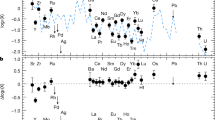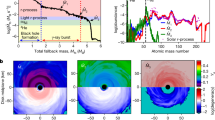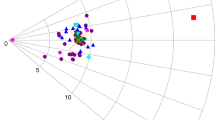Abstract
The metal abundance of the hot plasma that permeates galaxy clusters represents the accumulation of heavy elements produced by billions of supernovae1. Therefore, X-ray spectroscopy of the intracluster medium provides an opportunity to investigate the nature of supernova explosions integrated over cosmic time. In particular, the abundance of the iron-peak elements (chromium, manganese, iron and nickel) is key to understanding how the progenitors of typical type Ia supernovae evolve and explode2,3,4,5,6. Recent X-ray studies of the intracluster medium found that the abundance ratios of these elements differ substantially from those seen in the Sun7,8,9,10,11, suggesting differences between the nature of type Ia supernovae in the clusters and in the Milky Way. However, because the K-shell transition lines of chromium and manganese are weak and those of iron and nickel are very close in photon energy, high-resolution spectroscopy is required for an accurate determination of the abundances of these elements. Here we report observations of the Perseus cluster, with statistically significant detections of the resonance emission from chromium, manganese and nickel. Our measurements, combined with the latest atomic models, reveal that these elements have near-solar abundance ratios with respect to iron, in contrast to previous claims. Comparison between our results and modern nucleosynthesis calculations12,13,14 disfavours the hypothesis that type Ia supernova progenitors are exclusively white dwarfs with masses well below the Chandrasekhar limit (about 1.4 times the mass of the Sun). The observed abundance pattern of the iron-peak elements can be explained by taking into account a combination of near- and sub-Chandrasekhar-mass type Ia supernova systems, adding to the mounting evidence that both progenitor types make a substantial contribution to cosmic chemical enrichment5,15,16.
This is a preview of subscription content, access via your institution
Access options
Access Nature and 54 other Nature Portfolio journals
Get Nature+, our best-value online-access subscription
$29.99 / 30 days
cancel any time
Subscribe to this journal
Receive 51 print issues and online access
$199.00 per year
only $3.90 per issue
Buy this article
- Purchase on Springer Link
- Instant access to full article PDF
Prices may be subject to local taxes which are calculated during checkout



Similar content being viewed by others
References
Mushotzky, R. et al. Measurement of the elemental abundances in four rich clusters of galaxies. I. Observations. Astrophys. J. 466, 686–694 (1996)
Finoguenov, A., Matsushita, K., Böhringer, H., Ikebe, Y. & Arnaud, M. X-ray evidence for spectroscopic diversity of type Ia supernovae. XMM observation of the elemental abundance pattern in M 87. Astron. Astrophys. 381, 21–31 (2002)
Mernier, F. et al. Origin of central abundances in the hot intra-cluster medium. II. Chemical enrichment and supernova yield models. Astron. Astrophys. 595, A126 (2016)
Maeda, K. et al. Nebular spectra and explosion asymmetry of Type Ia supernovae. Astrophys. J. 708, 1703–1715 (2010)
Seitenzahl, I. R., Cescutti, G., Röpke, F. K., Ruiter, A. J. & Pakmor, R. Solar abundance of manganese: a case for near Chandrasekhar-mass Type Ia supernova progenitors. Astron. Astrophys. 559, L5 (2013)
Yamaguchi, H. et al. A Chandrasekhar mass progenitor for the Type Ia supernova remnant 3C 397 from the enhanced abundances of nickel and manganese. Astrophys. J. 801, L31 (2015)
Dupke, R. A. & White, R. E. III . Constraints on type Ia supernova models from X-ray spectra of galaxy clusters. Astrophys. J. 528, 139–144 (2000)
Gastaldello, F. & Molendi, S. Ni abundance in the core of the Perseus cluster: an answer to the significance of resonant scattering. Astrophys. J. 600, 670–680 (2004)
De Plaa, J. et al. Constraining supernova models using the hot gas in clusters of galaxies. Astron. Astrophys. 465, 345–355 (2007)
De Grandi, S. & Molendi, S. Metal abundances in the cool cores of galaxy clusters. Astron. Astrophys. 508, 565–574 (2009)
Mernier, F. et al. Origin of central abundances in the hot intra-cluster medium. I. Individual and average abundance ratios from XMM-Newton EPIC. Astron. Astrophys. 592, A157 (2016)
Seitenzahl, I. R. et al. Three-dimensional delayed-detonation models with nucleosynthesis for Type Ia supernovae. Mon. Not. R. Astron. Soc. 429, 1156–1172 (2013)
Pakmor, R. et al. Normal type Ia supernovae from violent mergers of white dwarf binaries. Astrophys. J. 747, L10 (2012)
Woosley, S. E. & Kasen, D. Sub-Chandrasekhar mass models for supernovae. Astrophys. J. 734, 38 (2011)
Scalzo, R. A., Ruiter, A. J. & Sim, S. A. The ejected mass distribution of Type Ia supernovae: a significant rate of non-Chandrasekhar-mass progenitors. Mon. Not. R. Astron. Soc. 445, 2535–2544 (2014)
Blondin, S., Dessart, L., Hillier, D. J. & Khokhlov, A. M. Evidence for sub-Chandrasekhar-mass progenitors of Type Ia supernovae at the faint end of the width-luminosity relation. Mon. Not. R. Astron. Soc. 470, 157–165 (2017)
Hitomi Collaboration. The quiescent intracluster medium in the core of the Perseus cluster. Nature 535, 117–121 (2016)
Loewenstein, M. & Mushotzky, R. F. Measurement of the elemental abundances in four rich clusters of galaxies. II. The initial mass function and mass loss in elliptical galaxies, enrichment, and energetics in the ICM. Astrophys. J. 466, 695–703 (1996)
Matsushita, K., Sakuma, E., Sasaki, T., Sato, K. & Simionescu, A. Metal-mass-to-light ratios of the Perseus cluster out to the virial radius. Astrophys. J. 764, 147 (2013)
Riess, A. G. et al. Observational evidence from supernovae for an accelerating universe and a cosmological constant. Astron. J. 116, 1009–1038 (1998)
Perlmutter, S. et al. Measurements of Ω and Λ from 42 high-redshift supernovae. Astrophys. J. 517, 565–586 (1999)
Whelan, J. & Iben, I. Jr. Binaries and supernovae of type I. Astrophys. J. 186, 1007–1014 (1973)
Webbink, R. F. Double white dwarfs as progenitors of R Coronae Borealis stars and Type I supernovae. Astrophys. J. 277, 355–360 (1984)
Sim, S. A. et al. Detonations in sub-Chandrasekhar-mass C+O white dwarfs. Astrophys. J. 714, L52–L57 (2010)
Lodders, K., Palme, H. & Gail, H.-P. In Solar System (ed. Trümper, J. E. ) 712–770 (Vol. VI/4B of Landolt Börnstein, New Series, Springer, 2009)
Conroy, C., Graves, G. J. & van Dokkum, P. G. Early-type galaxy archeology: ages, abundance ratios, and effective temperatures from full-spectrum fitting. Astrophys. J. 780, 33 (2013)
Nomoto, K., Kobayashi, C. & Tominaga, N. Nucleosynthesis in stars and the chemical enrichment of galaxies. Annu. Rev. Astron. Astrophys. 51, 457–509 (2013)
Sato, K. et al. Type Ia and II supernovae contributions to metal enrichment in the intracluster medium observed with Suzaku. Astrophys. J. 667, L41–L44 (2007)
Bulbul, E., Smith, R. K. & Loewenstein, M. A new method to constrain supernova fractions using X-ray observations of clusters of galaxies. Astrophys. J. 753, 54 (2012)
Werner, N., Urban, O., Simionescu, A. & Allen, S. W. A uniform metal distribution in the intergalactic medium of the Perseus cluster of galaxies. Nature 502, 656–658 (2013)
Eckart, M. E. et al. Ground calibration of the Astro-H (Hitomi) soft x-ray spectrometer. Proc. SPIE 9905 99053W (2016)
Angelini, L. et al. Astro-H data analysis, processing and archive. Proc. SPIE 9905, 990514 (2016)
Leutenegger, M. A. et al. In-flight verification of the calibration and performance of the ASTRO-H (Hitomi) Soft X-Ray Spectrometer. Proc. SPIE 9905, 99053U (2016)
Kelley, R. L. et al. The Astro-H high resolution soft x-ray spectrometer. Proc. SPIE 9905, 99050V (2016)
Porter, F. S. et al. In-flight performance of the Soft X-ray Spectrometer detector system on Astro-H. Proc. SPIE 9905, 99050W (2016)
Ferruit, P., Adam, G., Binette, L. & Pécontal, E. TIGER observations of the low and high velocity components of NGC 1275. New Astron. 2, 345–363 (1997)
Okajima, T. et al. First peek of ASTRO-H Soft X-ray Telescope (SXT) in-orbit performance. Proc. SPIE 9905, 99050Z (2016)
Cash, W. Parameter estimation in astronomy through application of the likelihood ratio. Astrophys. J. 228, 939–947 (1979)
Tamura, T. et al. X-ray spectroscopy of the core of the Perseus cluster with Suzaku: elemental abundances in the intracluster medium. Astrophys. J. 705, L62–L66 (2009)
Foster, A. R., Ji, L., Smith, R. K. & Brickhouse, N. S. Updated atomic data and calculations for X-ray spectroscopy. Astrophys. J. 756, 128 (2012)
Churazov, E., Forman, W., Jones, C., Sunyaev, R. & Böhringer, H. XMM-Newton observations of the Perseus cluster - II. Evidence for gas motions in the core. Mon. Not. R. Astron. Soc. 347, 29–35 (2004)
Kalberla, P. M. W. et al. The Leiden/Argentine/Bonn (LAB) Survey of Galactic HI. Final data release of the combined LDS and IAR surveys with improved stray-radiation corrections. Astron. Astrophys. 440, 775–782 (2005)
Zhuravleva, I. et al. Resonant scattering in the Perseus Cluster: spectral model for constraining gas motions with Astro-H. Mon. Not. R. Astron. Soc. 435, 3111–3121 (2013)
Sanders, J. S. & Fabian, A. C. A deeper X-ray study of the core of the Perseus galaxy cluster: the power of sound waves and the distribution of metals and cosmic rays. Mon. Not. R. Astron. Soc. 381, 1381–1399 (2007)
Kaastra, J. S., Mewe, R. & Nieuwenhuijzen, H. In UV and X-ray Spectroscopy of Astrophysical and Laboratory Plasmas (eds Yamashita, K. & Watanabe, T. ) 411–414 (Universal Academy Press, 1996)
Simionescu, A. et al. Chemical enrichment in the cluster of galaxies Hydra A. Astron. Astrophys. 493, 409–424 (2009)
Ezer, C. et al. Uniform contribution of supernova explosions to the chemical enrichment of Abell 3112 out to R200 . Astrophys. J. 836, 110 (2017)
Mulchaey, J. S., Kasliwal, M. M. & Kollmeier, J. A. Calcium-rich gap transients: solving the calcium conundrum in the intracluster medium. Astrophys. J. 780, L34 (2013)
Fink, M. et al. Three-dimensional pure deflagration models with nucleosynthesis and synthetic observables for Type Ia supernovae. Mon. Not. R. Astron. Soc. 438, 1762–1783 (2014)
Travaglio, C., Hillebrandt, W., Reinecke, M. & Thielemann, F.-K. Nucleosynthesis in multi-dimensional SN Ia explosions. Astron. Astrophys. 425, 1029–1040 (2004)
Travaglio, C., Röpke, F. K., Gallino, R. & Hillebrandt, W. Type Ia supernovae as sites of the p-process: two-dimensional models coupled to nucleosynthesis. Astrophys. J. 739, 93 (2011)
Bravo, E. & Martnez-Pinedo, G. Sensitivity study of explosive nucleosynthesis in type Ia supernovae: Modification of individual thermonuclear reaction rates. Phys. Rev. C 85, 055805 (2012)
Tsujimoto, T. & Shigeyama, T. Diversity of Type Ia supernovae imprinted in chemical abundances. Astrophys. J. 760, L38 (2012)
Langanke, K. & Martnez-Pinedo, G. Shell-model calculations of stellar weak interaction rates: II. Weak rates for nuclei in the mass range A=45–65 in supernovae environments. Nucl. Phys. A 673, 481–508 (2000)
Acknowledgements
Acknowledgements are provided in the Supplementary Information.
Author information
Authors and Affiliations
Consortia
Contributions
H.Y. wrote the manuscript. H.Y., S.N., A. Simionescu, E.B. and M.L. analysed the data. H.Y., K. Matsushita, M.L., A. Simionescu, S.N., K.S. and R.M. discussed the results. Y. Ishisaki confirmed the reliability of the observed results using his expertise in the SXS signal processing system. The science goals of Hitomi were discussed and developed over more than 10 years by the ASTRO-H Science Working Group (SWG), all members of which are authors of this manuscript. All the instruments were prepared by the joint efforts of the team. Calibration of the Perseus dataset was carried out by members of the SXS team. The manuscript was subject to an internal collaboration-wide review process. All authors reviewed and approved the final version of the manuscript.
Corresponding authors
Ethics declarations
Competing interests
The author declare no competing financial interests.
Additional information
Publisher's note: Springer Nature remains neutral with regard to jurisdictional claims in published maps and institutional affiliations.
Extended data figures and tables
Extended Data Figure 1 The SXS field of view overlaid on a Chandra image in the 1.8–9.0 keV band.
The corresponding sequence IDs of the Hitomi observations are given. Each side of the SXS field of view has an angular size of 3′ (about 64 kpc).
Extended Data Figure 2 Additional gain correction.
a–c, The data points indicate the difference ΔE = E′ − E0 between the measured (E′) and theoretical (E0) energies of each detected line at the given X-ray energy. The best-fitting parabolic functions are given as solid curves. The error bars correspond to the 1σ confidence level. a, b and c show the results from sequence 100040020, 100040030–50 (combined) and 100040060, respectively.
Extended Data Figure 3 Elemental abundances calculated with different model assumptions.
‘A’ and ‘S’ indicate the results obtained using the atomic databases AtomDB v.3.0.8 and SPEX v.3.03, respectively, and ‘S′’ represents an old atomic model (SPEX v.2.05, which does not contain Cr and Mn line data). Numerical designations are as follows: ‘1’, one-temperature fit with the Fe xxv resonance-scattering effect; ‘2’, one-temperature fit without the resonance-scattering effect; ‘3’, two-temperature fit with the resonance-scattering effect; ‘4’, two-temperature fit without the resonance-scattering effect. The error bars correspond to the 1σ confidence level.
Extended Data Figure 4 Elemental abundances of the Perseus cluster core from different X-ray measurements.
Relative abundances with respect to Fe (X/Fe, X = Si, S, Ar, Ca, Cr, Mn, Ni) normalized to the corresponding solar abundances25 (dashed line). The red circles are identical to those in Fig. 2 and represent the SXS measurements, with error bars that include both the 1σ statistical uncertainty and systematic uncertainty. The red diamonds show the same SXS measurements analysed with an outdated atomic model that was used in the XMM-Newton study. The blue triangles represent the XMM-Newton results11, as in Fig. 2. The green squares are abundances obtained from Suzaku observations of the innermost 2′ region of the Perseus cluster39, converted using the updated solar abundance table25 for direct comparison with the other measurements. The error bars are also converted to represent the statistical uncertainty at a 1σ confidence level.
Extended Data Figure 5 Weak emission lines at different energy resolutions.
a, SXS spectrum of the Perseus cluster around the Cr and Mn emission. The red line is the best-fitting model (model A1) with the Cr and Mn abundances set to zero. The bottom panel shows the ratio between the data and the model results. The error bars correspond to the 1σ confidence level. b, Simulated spectrum at the typical energy resolution of the XMM-Newton CCD data (MOS1 detector), assuming the best-fitting model for the SXS data and sufficiently long exposure time (4 Ms). This comparison demonstrates the robustness of our measurements of weak emission lines with high-resolution spectroscopy (see Methods for details).
Extended Data Figure 6 Effect of potential bias in the continuum-level estimate on the abundance measurement using weak emission lines.
a, Abundances of Cr (red), Mn (blue) and Fe (black) determined by intentionally adding a small offset to the continuum normalization (within ±3% of the measured value). The solid and dashed lines are obtained from our test analysis of the simulated CCD spectrum (Extended Data Fig. 5b) and the Hitomi spectrum, respectively. This illustrates that the CCD measurement of Cr and Mn abundances is sensitive to the accuracy of the continuum-level determination because of the weakness of the emission and the low spectral resolution. The Fe abundance is less subject to such uncertainty, even in the CCD measurement, owing to the much larger equivalent width of the emission. b, Abundance ratios of Cr/Fe (red) and Mn/Fe (blue), calculated using the values in a as a function of offset in the continuum level.
Supplementary information
Supplementary Information
This file contains the full acknowledgments for this paper. (PDF 105 kb)
Rights and permissions
About this article
Cite this article
Hitomi Collaboration. Solar abundance ratios of the iron-peak elements in the Perseus cluster. Nature 551, 478–480 (2017). https://doi.org/10.1038/nature24301
Received:
Accepted:
Published:
Issue Date:
DOI: https://doi.org/10.1038/nature24301
This article is cited by
-
Frontiers in accretion physics at high X-ray spectral resolution
Nature Astronomy (2022)
-
High-entropy ejecta plumes in Cassiopeia A from neutrino-driven convection
Nature (2021)
-
High-resolution X-ray spectroscopy of astrophysical plasmas with X-ray microcalorimeters
Reviews of Modern Plasma Physics (2021)
-
Voyage through the hidden physics of the cosmic web
Experimental Astronomy (2021)
Comments
By submitting a comment you agree to abide by our Terms and Community Guidelines. If you find something abusive or that does not comply with our terms or guidelines please flag it as inappropriate.



